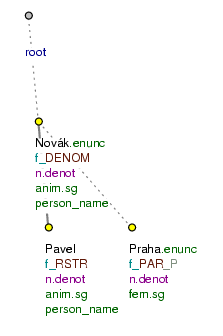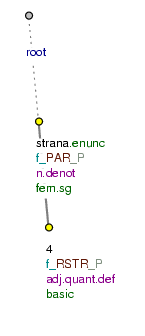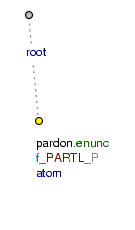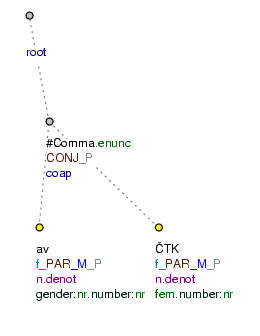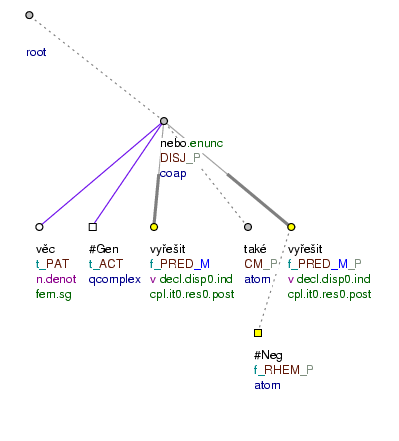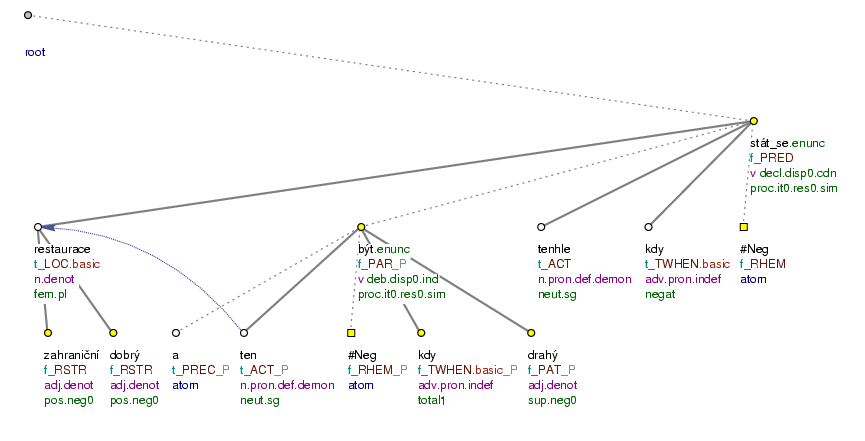Parenthesis proper is a parenthesis used just in a given context (situation).
This type can be further classified:
-
parenthesis integrated in the syntax of the sentence.
If the parenthesis is syntactically integrated in the sentence, its effective root node is assigned a functor according to the type of dependency (it has w.r.t. its governing node).
Examples:
On byl vždycky přísný (učitel.
PAT). (=lit. He was always strict (teacher)) Fig. 6.105Podmětem (jestliže vyjadřuje.
CONDčinnost), může být i infinitiv. (=The subject (if it expresses an activity) can also be an infinitive) Fig. 6.107Pavel Novák (z Prahy.
DIR1). (=P.N. (from Praha)) Fig. 6.41Vidím náš dům (a naši zahradu.
PAT). (=I can see our house (and our garden))Mužstvo (které loni zvítězilo.
RSTR) skončilo až třetí. (=The team (which won last year) took third place) -
parenthesis not integrated in the syntax of the sentence.
If the parenthesis is not syntactically integrated in the syntax of the sentence, it is analyzed as an independent clause (see Section 4, "Verbal and non-verbal clauses"). The annotation varies with the clause type:
-
if the syntactically non-integrated parenthesis is a verbal clause (the
PREDfunctor) or a nominative clause (theDENOMfunctor), the effective root nodes of the parenthesis are assigned thePARfunctor.Examples:
Pavel Novák (Praha.
PAR). Fig. 6.109Mužstvo skončilo až třetí (loni bylo.
PARprvní). (=The team took only third place (last year they won)) Fig. 6.110Žádná města (jen { hrát.
PAR} Praha) nehrála tak významnou úlohu. (=No towns (only Praha) played such an important role) Fig. 6.111Přijel na chatu (čekali.
PARho a těšili se.PAR). (=He came to the cottage (they had been waiting for him and looking forward to seeing him)) Fig. 6.112The root node of a syntactically non-integrated parenthesis, whose effective roots are assigned the
PARfunctor, is assigned a value in thesentmodattribute (see Section 7, "Thesentmodattribute"). -
if the syntactically non-integrated parenthesis is a vocative clause (the
VOCATfunctor) or an interjectional clause (thePARTLfunctor), the effective root nodes of the parenthesis are assigned the appropriate functors, i.e.VOCATorPARTL(and notPAR). If the vocative or interjectional clause is clearly a parenthesis (it is marked by brackets or dashes, for example), all the nodes of the parenthesis are assigned the1value in theis_parenthesisattribute.The effective root nodes of vocative and interjectional clauses are never assigned the
PARfunctor. They are assigned theVOCATorPARTLfunctor even if they occur lower in the structure (see also Section 4.3, "Connecting verbal and non-verbal clauses").Example:
Zase nesehnal práci (ach.
PARTL). [is_parenthesis=1] (=He didn't find a job again (oh dear))
The root node of a parenthesis is represented as immediately dependent on the node the parenthesis most directly relates to.
-
Parentheses can also be found used on their own (then, they are always typographically marked, usually by using brackets). For example:
(strana 4) (=(page 4)) Fig. 6.113
(Pardon!) Fig. 6.114
(av, čtk) Fig. 6.115
If the independent parenthetic clause is a verbal or nominative clause, its effective root node has the PAR functor (cf. Fig. 6.113 and Fig. 6.115). If it is a vocative or interjectional clause, its effective root node has the VOCAT or PARTL functor (cf. Fig. 6.114).
Figure 6.107. Parenthesis integrated in the syntax of the sentence
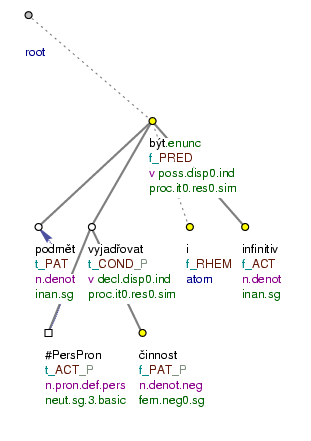
Podmětem (jestliže vyjadřuje činnost), může být i infinitiv. (=lit. Subject (if expresses activity) can be also infinitive)
Figure 6.108. Parenthesis integrated in the syntax of the sentence
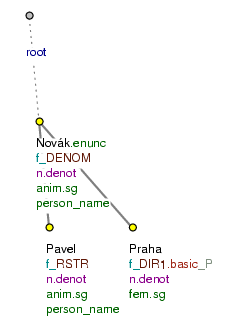
Pavel Novák (z Prahy). (=lit. Pavel Novák (from Praha))
Figure 6.110. Parenthesis not integrated in the syntax of the sentence
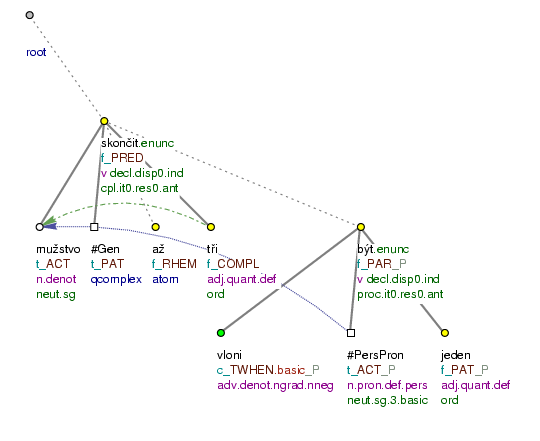
Mužstvo skončilo až třetí (loni bylo první). (=lit. Team ended only third (last_year was first))
Figure 6.111. Parenthesis not integrated in the syntax of the sentence
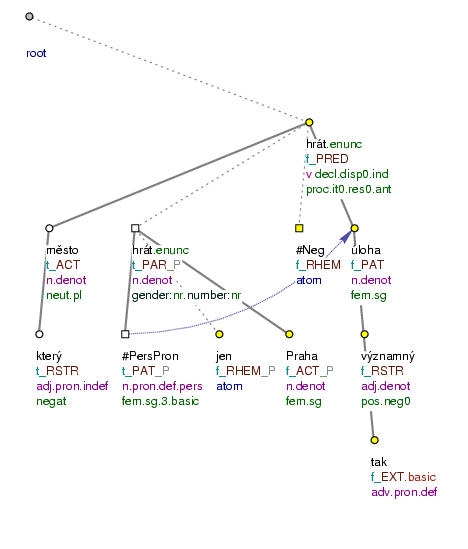
Žádná města (jen Praha) nehrála tak významnou úlohu. (=lit. No towns (only Praha) not_played such important role)
Figure 6.112. Parenthesis not integrated in the syntax of the sentence
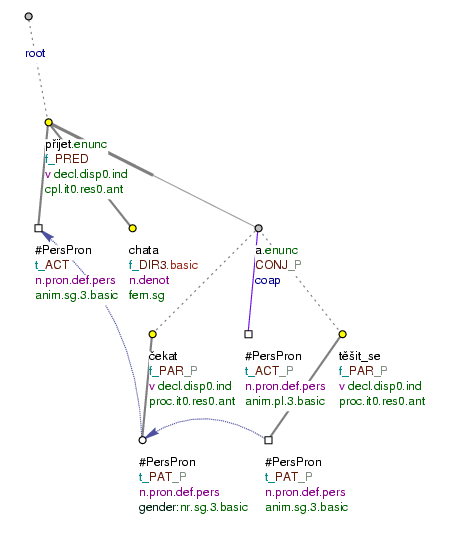
Přijel na chatu (čekali ho a těšili se). (=lit. (He) came to cottage ((they) waited for_him and looked_forward_to REFL))
Parenthesis introduced by a coordinating connective. A special subtype of syntactically integrated parenthesis are cases when there is coordination in the sentence and one of the coordinated expressions is marked as a parenthesis. For example:
Přišel tam Petr (a Pavel). (=Petr (and Pavel) came there) Fig. 6.106
Věc se vyřeší (nebo taky nevyřeší). (=The thing will be solved (or it will not)) Fig. 6.116
Kup rohlíky (a máslo). (=Buy some rolls (and butter))
Those members of a paratactic connection that are a parenthesis are analyzed in accordance with the rules for paratactic structures (see Section 6.1, "Representing parataxis in a tectogrammatical tree"), i.e. they depend directly on the root node of the paratactic structure. All nodes that are part of a parenthesis have the 1 value in the is_parenthesis attribute. If the connective (i.e. the paratactic structure root node) is also part of the parenthesis, it also has the value 1 in the is_parenthesis attribute.
This way of representing coordinated parenthetic expressions is only used if the parenthesis is clearly integrated in the syntax of the sentence. The following examples are analyzed as syntactically non-integrated parentheses:
V dobrých zahraničních restauracích (a nemusí to být vždy nejdražší) by se tohle nikdy nestalo. (=In good restaurants in other countries (and these don't have to be the most expensive ones), this would never happen) Fig. 6.117
Čína je nyní, a já doufám, že i nadále bude, důležitý partner USA. (=China is (and I hope it also will be) an important partner of the USA)
Takoví lidé, a patří mezi ně i pan předseda, nemají ve vedení co dělat. (=Such people (and the chair is one of them) should not be in the management)
In the examples above, the segments introduced by coordinating connectives are represented as parentheses syntactically non-integrated in the sentence. The effective root node of the parenthesis is assigned the PAR functor, the connective gets the PREC functor and depends on the node with the PAR functor.
